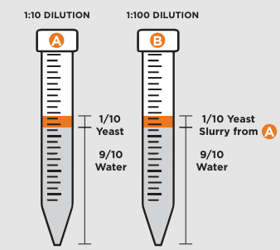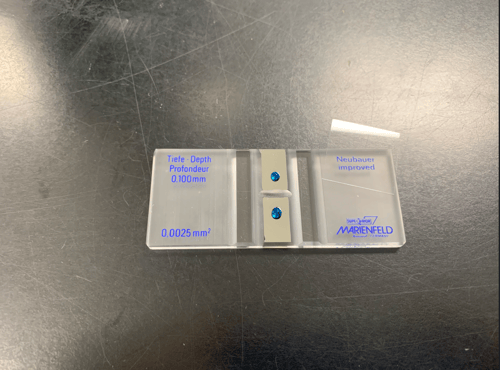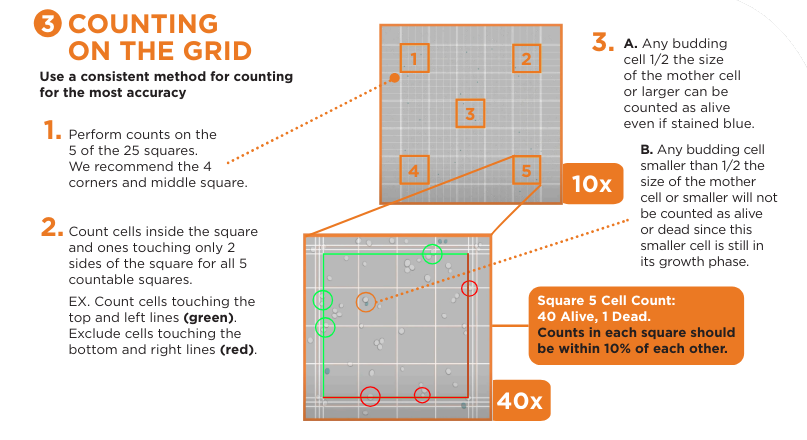Cell counting provides two vital metrics: the total amount of cells in a storage vessel and a culture’s viability (amount of living cells). This information can then be used to decide if a culture is capable of another healthy fermentation. In addition, it can be used to calculate the exact volume needed to achieve a target pitching rate.
Adjusting repitching volumes accurately and ensuring cultural health is impossible without this test. This test will reduce yeast costs by maintaining generational health and maximizing harvest volume efficiency.
We recommend performing cell counts in duplicate at a minimum and averaging the results.
Download Our pitch Rate & Cell Count Playbook
In this guide, we’ll learn how to control our pitch rate from ideal pitch rates to how to cell count and repitch for the next batch of beer.
- Explanation on Why Pitch Rates Matter
- Easy To Follow SOP for Cell Counting
- Quick Cheat Sheet Table for Estimation of Pitching by Weight Based on Viability
Cell Counting / Viability Steps
 Materials:
Materials:
Be sure to also see White Labs Microscope Kit!
Instructions:
1. Mix and Dilute the concentrated yeast slurry down to a 1:100 dilution.
- Note: If pulling a sample of beer from the fermenter, there is no need to perform this dilution.
- Note: For flocculant cells use 0.1% EDTA or 0.5% H2SO4. Remember to always note your dilution factor!


2. Mix and transfer 1mL of 1:100 sample into a new conical tube. Transfer 1mL of citrate methylene blue stain into the same tube creating a 1:200 dilution.
- Note: Read sample within 1-5 minutes of dye introduction. Or dye will overstain the cells.
3. Mix the sample and use capillary action or pipette approximately 10uL of your sample in the center of the counting area on your hemocytometer. Gently lay a cover slip over the sample without creating any air bubbles. If unable to measure 10uL, place a drop smaller than a pea.
- Note: Wait 30 seconds to 1 minute after placing the coverslip to let the yeast settle.

4. Place a hemocytometer on the microscope stage and focus on 10x objective.
- A 5x5 grid should now be in view with the yeast cells spread out evenly.
5. Once focused, move on to the 40x objective. At 40x, focus on a single square of the 5x5 grid. It will appear as a 4x4 grid, you will now be able to count the individual cells.
Note: It is best to have 25-80 yeast cells per microscope square at 400x with cells evenly distributed.
6. Record the total cell count and total number of live & dead cells individually. Move on to the next 4x4 square until all 5 squares are counted.

Considerations when Cell Counting:
- If performing viability counts, dead cells will stain dark blue using Citrate Methylene Blue and purple/pink using Alkaline Methylene Violet. Non-viable cells do not have the metabolic capability to expel the intruding dye.
- Cells that appear stained are dead cells. Do not count cells that are pale in color as dead. Some budding cells will also stain; do not count these cells as non-viable as they can
- If a budding cell is over 50% of the mother cell's size, count this as a separate and living cell.
Viability Calculation:

Slurry Calculations:
 Another Example:
Another Example:
|
Cells counted
|
220
|
|
Squares
|
25 total/5 counted = 5 (multiply by this number to get the total number of squares in the grid)
|
|
Dilution factor
|
200 (A 1:100 dilution, then a 1:2 dilution of yeast and Methylene Blue)
|
|
Volume of Chamber (constant)
|
10,000
|
= 220 x 5 x 200 x 10,000 = 2,200,000,000 = 2.2 x 109 or 2.2 billion cells/mL



 Materials:
Materials:




 Another Example:
Another Example:

